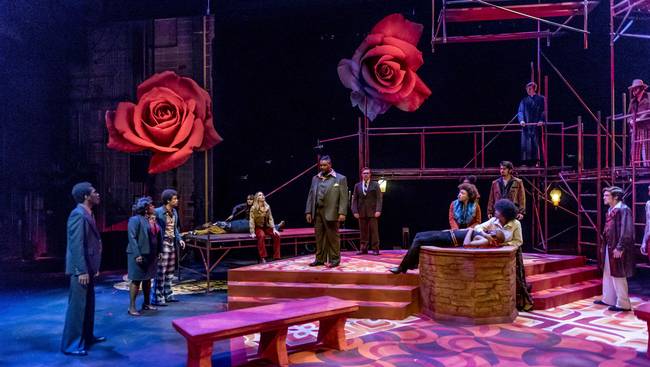“For never was a story of more woe than this of Juliet and her Romeo.”
Spoiler alert: that’s the last line of Shakespeare’s immortal tragedy about a pair of star-crossed and starry-eyed youngsters. But spoilers shouldn’t really apply to a play written 420 years ago; and they especially shouldn’t apply to one of the most frequently staged, frequently filmed, frequently referenced, and frequently satirized plays of all time. With Romeo & Juliet, even if you haven’t seen it, you’ve seen it.
The good news coming out of Krannert Center these days, though, is that you haven’t seen it quite like this.
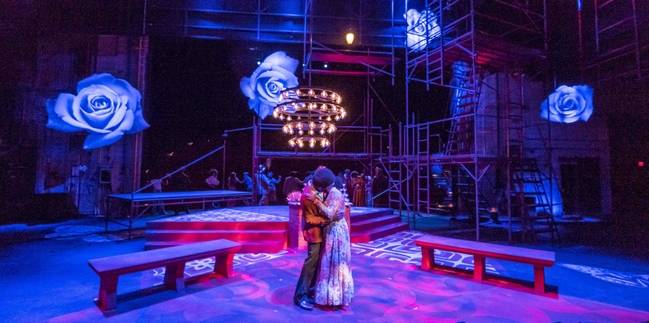
Director Robert G. Anderson’s Illinois Theatre production of the well-worn romantic tale sets its scene in a Verona that looks and sounds a lot like 1970s urban America. It’s a cool, slick, jive-y place, where a nostalgia for the TV show Good Times isn’t unreasonable. (I mean that as a compliment, by the way. The dedication to time and place here is Dy-no-mite.) This lends another layer of character and texture, for, as Shakespeare’s language retains its rhyme, there is an attitude to the delivery that is in keeping with both the emotions of the characters and the vernacular of the setting. So, while you are sure to be expecting talk of friars and shrift and “what light through yonder window breaks,” you should also expect tall heels and funky music and some very shiny shirts (costume design by Sharne van Rynevald, sound design by David Greenberg).
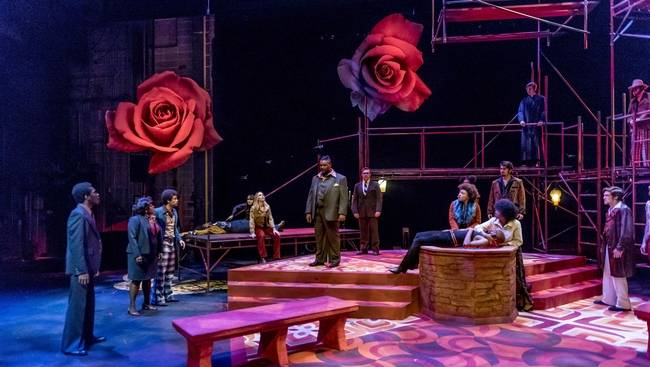
The cast works hard in the opening moments to create this sense of place. I’ll admit that, at first, I thought they were working a bit too hard, laying it on a bit too thick. But here’s the thing: Somewhere around the balcony scene, I didn’t care. Or, rather, I didn’t care about that. I wasn’t noticing the fashions and the posturing as much as I was the ill-advised, all-consuming passion of Romeo for his Juliet, and vice versa. The cast, designers, and director had done their job admirably, and I was immersed. Which is how it’s supposed to work with Shakespeare.
I was also noticing—and you will, too—that this production Never Stops Moving.
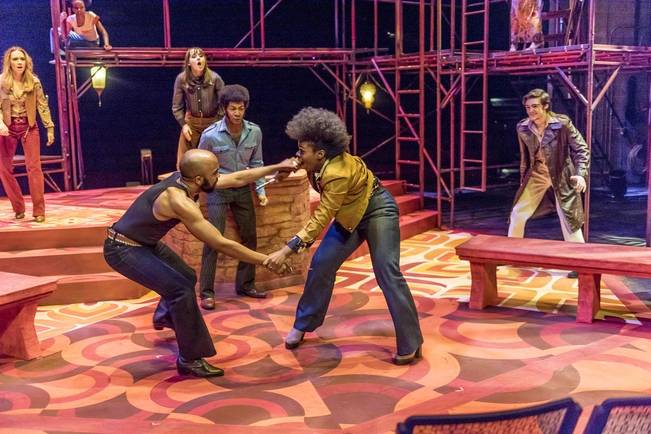
Staged intimately and with limited seating, the set is dominated by scenic designer Regina Garcia’s multipurpose scaffolding unit and draped in bold swaths of color by lighting designer Eric Van Tassell. On this set, as well as above it and behind it, there is a relentless momentum to the entrances and exits that keeps the energy constant and propels the story forward. We are whisked along on a streamlined ride, breezing over a few noticeable omissions (no Queen Mab speech, for instance) to a conclusion some 100 minutes later that is no less powerful for having arrived quickly. This production may be fleet of foot, but it is by no means lacking heart.
Although the entire ensemble is solid and almost constantly in motion, there are a few standout performances. Among these are Xavier Roe and Alexis Walker, who play Romeo and Juliet, respectively. They bring just the right amount of impetuous joy to their young love, and an equal measure of hotheaded distress when (spoiler?) things don’t turn out well. You believe their infatuation, their elation, and their devastation; plus, they’re cute as hell together.
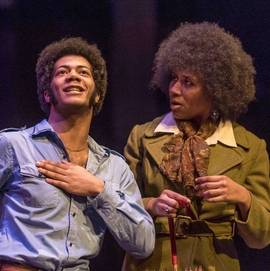 Their major co-conspirators, Friar Laurence (Raffeal Sears) and the Nurse (Noelle Klyce, right, with Xavier Roe), are played with a beautiful mixture of wisdom and wiseass, infusing by-now-cliché paternal and maternal figures with additional depth and warmth. Their scenes, which could have amounted to expository connective tissue, are full of texture and are, perhaps, the best in the play at relaying the intention of Shakespeare’s words while establishing—cementing, really—the world of this production.
Their major co-conspirators, Friar Laurence (Raffeal Sears) and the Nurse (Noelle Klyce, right, with Xavier Roe), are played with a beautiful mixture of wisdom and wiseass, infusing by-now-cliché paternal and maternal figures with additional depth and warmth. Their scenes, which could have amounted to expository connective tissue, are full of texture and are, perhaps, the best in the play at relaying the intention of Shakespeare’s words while establishing—cementing, really—the world of this production.
And what a world it is.
Illinois Theatre’s Romeo & Juliet, directed and adapted by Robert G. Anderson (with co-adapter Andrea Stevens), continues its run at Krannert Center for the Performing Arts through March 12 with two shows a day (7 and 9:30 p.m. on show nights, 3 and 5:30 p.m. on matinee days) and tickets are already hard to come by. The KCPA website currently shows waitlists for every single performance, but that doesn’t mean you shouldn’t try to see it. In fact, that probably means you should.
Photos by Darrell Hoemann courtesy of Krannert Center for the Performing Arts.
Note: Corrections have been made to this article about Illinois Theatre’s stellar show, including Andrea Stevens as co-adapter and correctly spelling lighting designer Eric Van Tassell’s name. We apologize for any inconvenience.








